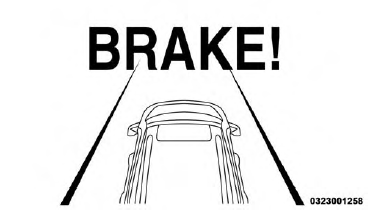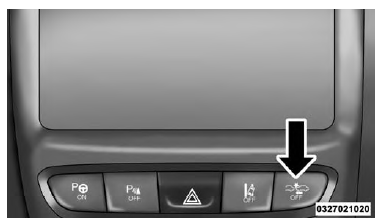Jeep Cherokee (KL): Forward collision warning (fcw) with mitigation
The Forward Collision Warning (FCW) system with
mitigation provides the driver with audible warnings,
visual warnings (within the EVIC/DID), and may apply
a brake jerk to warn the driver when it detects a potential
frontal collision. The warnings and limited braking are
intended to provide the driver with enough time to react,
avoid or mitigate the potential collision. NOTE: FCW monitors the information from the forward
looking sensors as well as the Electronic Brake Controller
(EBC), to calculate the probability of a forward collision.
When the system determines that a forward collision is
probable, the driver will be provided with audible and
visual warnings and may provide a brake jerk warning. If the driver does not take action based upon these
progressive warnings, then the system will provide a
limited level of active braking to help slow the vehicle
and mitigate the potential forward collision. If the driver
reacts to the warnings by braking and the system determines
that the driver intends to avoid the collision by
braking but has not applied sufficient brake force, the
system will compensate and provide additional brake
force as required.
If a Forward Collision Warning with Mitigation event
begins at a speed below 20 mph (32 km/h), the system
may provide the maximum braking possible to mitigate
the potential forward collision. If the Forward Collision
Warning with Mitigation event stops the vehicle completely,
the system will hold the vehicle at standstill for
two seconds and then release the brakes. When the system determines a collision with the vehicle
in front of you is no longer probable, the warning
message will be deactivated. NOTE: WARNING! Forward Collision Warning (FCW) is not intended to
avoid a collision on its own, nor can FCW detect
every type of potential collision. The driver has the
responsibility to avoid a collision by controlling the
vehicle via braking and steering. Failure to follow
this warning could lead to serious injury or death. NOTE: The default status of FCW is "On", this allows
the system to warn you of a possible collision with the
vehicle in front of you. The forward collision button is located on the switch
panel below the Uconnect display.
To turn the FCW system OFF, push the forward collision
button once to turn the system OFF (LED turns on).
To turn the FCW system back ON, push the forward
collision button again to turn the system ON (LED
turns off). NOTE: The FCW system state is kept in memory from
one key cycle to the next. If the system is turned OFF, it
will remain off when the vehicle is restarted. The FCW Sensitivity And Active Braking Settings are
programmable through the Uconnect System. Refer to
"Uconnect Settings" in "Understanding Your Instrument
Panel" for further information.
The default status of FCW is the "Far" setting and the
Active Braking is the "On" setting, this allows the system
to warn you of a possible collision with the vehicle in
front of you when you are farther away and it applies
limited braking. This gives you the most reaction time to
avoid a possible collision.
Changing the FCW status to the "Near" setting, allows
the system to warn you of a possible collision with the
vehicle in front of you when you are much closer. This
setting provides less reaction time than the "Far" setting,
which allows for a more dynamic driving experience. NOTE: If the EVIC/DID displays "ACC/FCW Limited Functionality"
or "ACC/FCW Limited Functionality Clean Front
Windshield" momentarily, there may be a condition that
limits FCW functionality. Although the vehicle is still
drivable under normal conditions, the active braking
may not be fully available. Once the condition that
limited the system performance is no longer present, the
system will return to its full performance state. If the
problem persists, see your authorized dealer. Service FCW Warning If the system turns off, and the EVIC/DID displays: This indicates there is an internal system fault. Although
the vehicle is still drivable under normal conditions, have
the system checked by an authorized dealer.Forward Collision Warning (FCW) With Mitigation Operation

FCW Message
Turning FCW ON Or OFF

Forward Collision Button
Changing FCW And Active Braking Status
FCW Limited Warning
Other materials:
Diagnosis and testing
General information
Axle bearing problem conditions are usually caused
by:
Insufficient or incorrect lubricant.
Foreign matter/water contamination.
Incorrect bearing preload torque adjustment.
Incorrect backlash.
Axle gear problem conditions are usually the resu ...


